21 Types of Palm Tree Varieties You Need to Grow
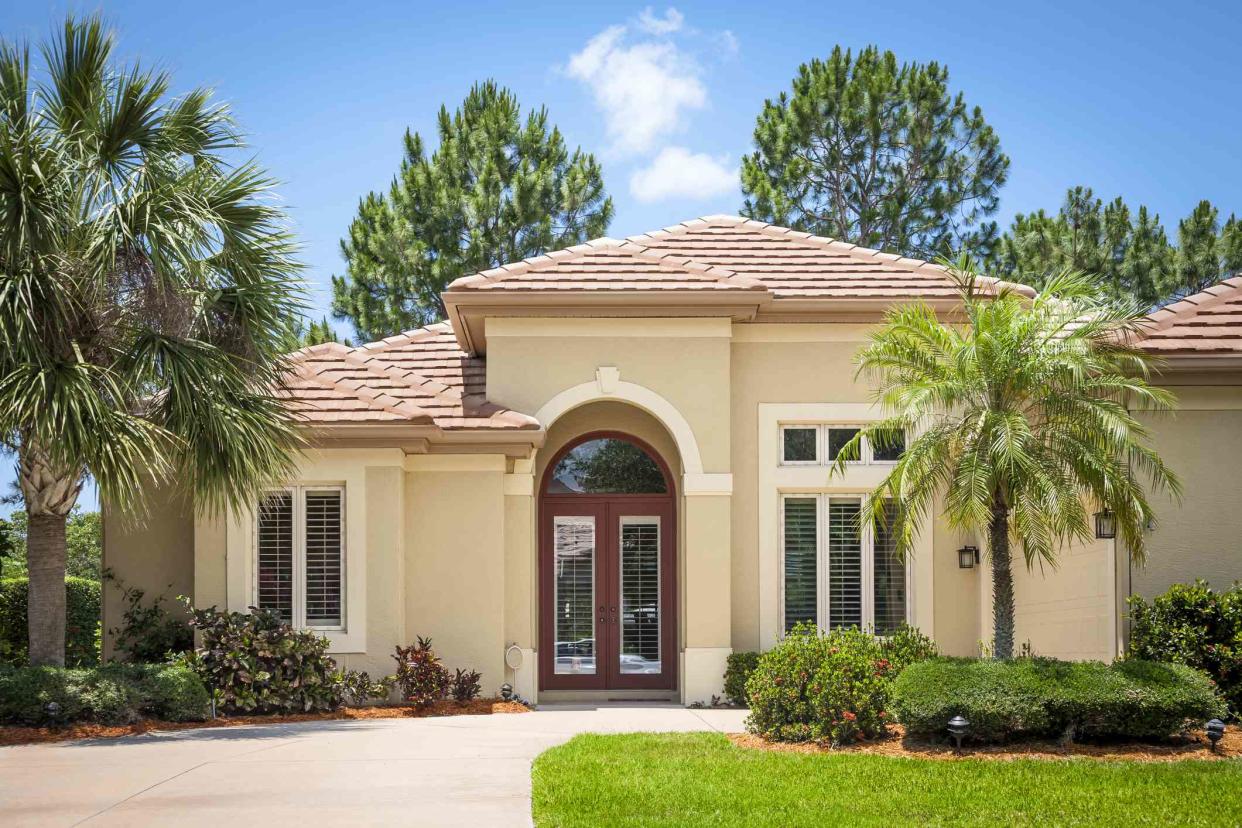
Marje / Getty Images
Some words that might spring to mind when you think of palm trees are tall, tropical, textural, stately, and lush. While these low-maintenance trees often need lots of sun and warm temperatures to thrive, many species are surprisingly versatile.
We’ve pulled together a list of palm tree varieties, including surprisingly cold-hardy species you’re not limited to planting in the sultry south. There are also plenty of palm trees you can grow indoors.
Date Palm Tree
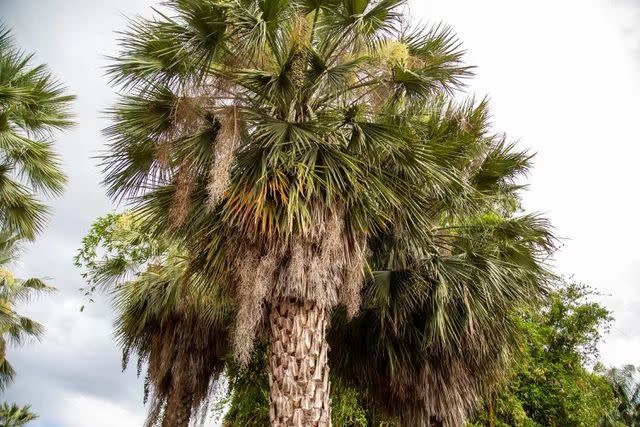
The Spruce / Krystal Slagle
The date palm is perhaps the most well-known palm tree, famed for its sweet, edible fruits. Young, slow-growing plants can grow in containers, but mature date palms need sufficient space in your yard as they can grow to reach 50 feet.
You can appreciate the arching, feather-like fronds without too much effort. These drought-tolerant trees just need well-drained soil and sufficient sun.
Name: Date Palm Tree (Phoenix dactylifera)
Hardiness Zones: 9-11
Light: Full sun
Soil Needs: Well-draining, loamy, sandy
Water: Drought-tolerant but prefers even moisture
Mature Size: 50-80 ft. tall outdoors
Windmill Palm Tree
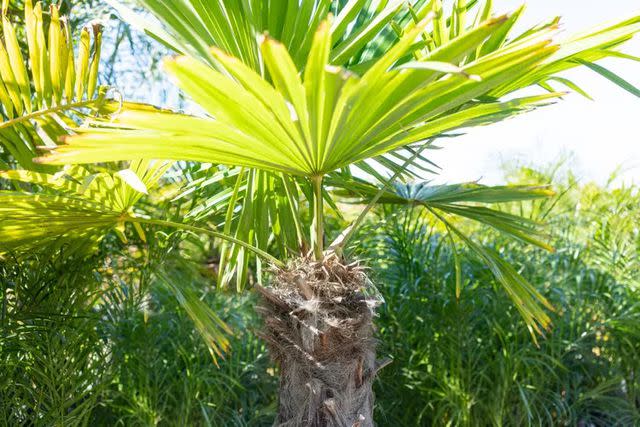
The Spruce / Almar Creative
Palms are associated with warm southern states, but the windmill palm is one of the most cold-hardy palm tree varieties. It can handle temperatures as low as 10°F.
Mature palms rarely grow over 25 feet, so their compact form makes them popular for small yards or to grow in containers on patios. The fan-shaped fronds thrive with little maintenance, but, like many palm species, these plants are susceptible to root rot, so watch out for overwatering.
Name: Windmill Palm Tree (Trachycarpus fortunei)
Hardiness Zones: 8-11
Light: Partial shade
Soil Needs: Well-draining
Water: Drought tolerant once established, but requires even moisture when young
Mature Size: 10-40 ft. tall outdoors
Mexican Fan Palm
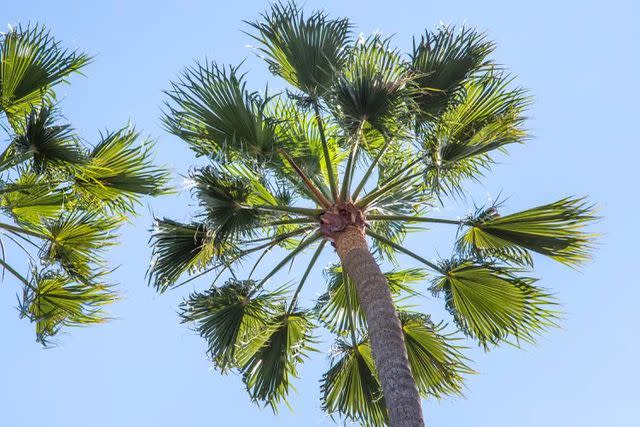
The Spruce / Krystal Slagle
Mexican fan palms are best suited to large yards, as these fast-growing species with distinctive fan-shaped fronds are very tall when mature. Be aware the species isn’t as drought- or storm-tolerant as some palm trees, and it’s susceptible to various fungal diseases. It’s also moderately invasive in parts of California.
Name: Mexican Fan Palm (Washingtonia robusta)
Hardiness Zones: 9-11
Light: Full sun
Soil Needs: Well-draining, loamy, sandy
Water: Prefers deep irrigation once dry
Mature Size: 50-100 ft. tall outdoors
European Fan Palm Tree
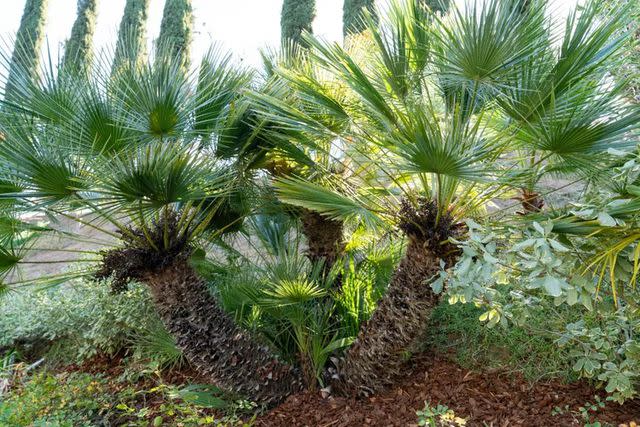
The Spruce / Almar Creative
The low-maintenance European fan palm is perfect for smaller spaces as it grows in a compact, shrub-like, clumping form. The eye-catching blue-green to silver-green fronds make it an ideal ornamental specimen. Another cold-hardy palm, this species can tolerate temperatures as low as 10°F, and it does well as a houseplant.
Name: European Fan Palm tree (Chamaerops humilis)
Hardiness Zones: 8-11
Light: Full sun, partial shade
Soil Needs: Well-draining, loamy
Water: Deep irrigation once dry
Mature Size: 6–15 ft. tall outdoors
Queen Palm
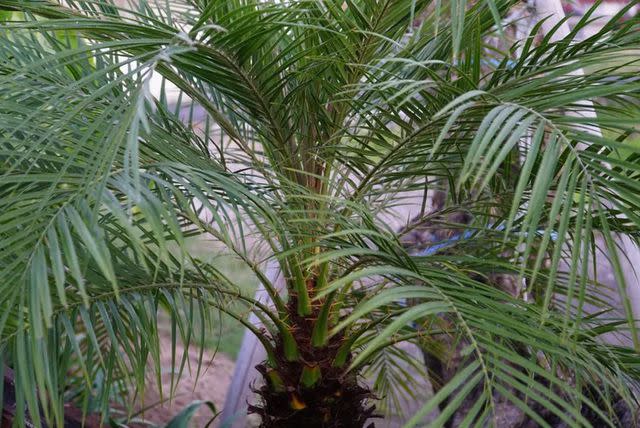
The Spruce / Gyscha Rendy
The medium-sized queen palm is a graceful addition to a large, warm, sunny yard, with the fluffy, feather-like fronds adding a tropical flair. It is drought tolerant once established and adapts to various conditions (providing it gets adequate sun).
Name: Queen Palm (Syagrus romanzoffiana)
Hardiness Zones: 9-11
Light: Full sun
Soil Needs: Well-draining, sandy
Water: Irrigate deeply when soil is dry
Mature Size: 50-60 ft. tall outdoors
Manila Palm
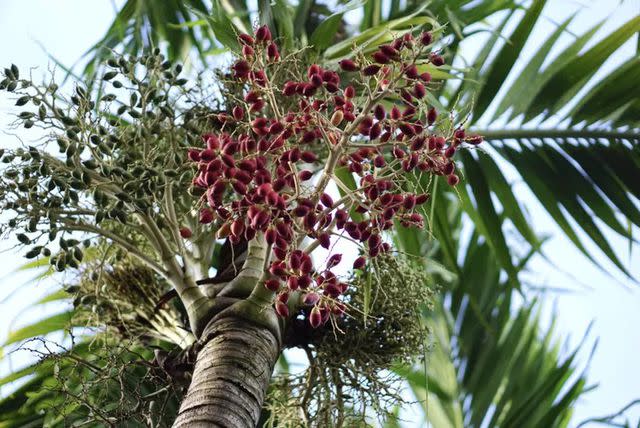
The Spruce / Gyscha Rendy
The Manila palm is an adaptable, low-maintenance species that isn’t too large. The plant develops showy clusters of bright red fruit in the fall and winter when grown outdoors. It prefers full sun but can still grow in partial shade. This species is highly sensitive to freezing temperatures and is best reserved for those warm southern regions or growing indoors.
Name: Manila Palm (Adonidia merrillii)
Hardiness Zones: 10-11
Light: Full sun
Soil Needs: Well-draining
Water: Prefers even moisture
Mature Size: 15-25 ft. tall outdoors
Robellini Palm
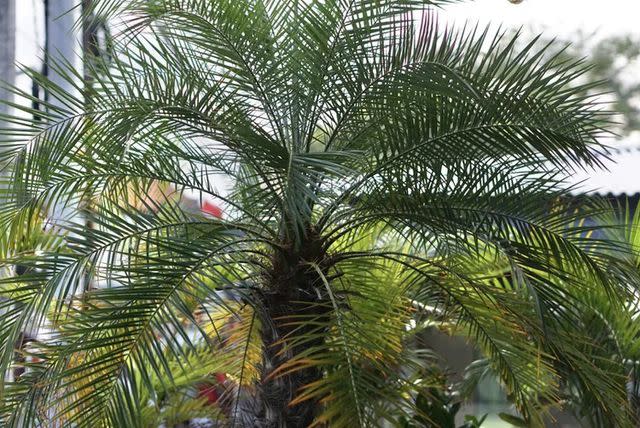
The Spruce / Gyscha Rendy
Also called the pygmy date palm, this species is perfect for those small yards where traditional palms are too tall. They do well growing in containers on warm decks, preferring to be slightly rootbound, and also as houseplants. Robellini palms are susceptible to nutrient deficiencies, so regular fertilization following a soil test is beneficial.
Name: Robellini Palm (Phoenix roebelenii)
Hardiness Zones: 10-11
Light: Full sun, partial sun
Soil Needs: Well-draining
Water: Water deeply when soil dries
Mature Size: 6-12 ft. tall outdoors
Parlor Palm
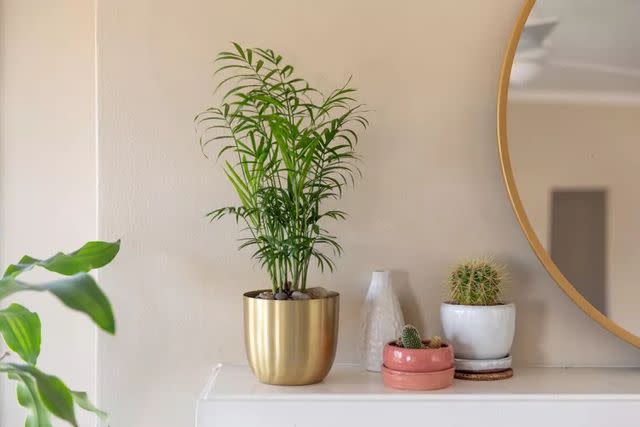
The Spruce / Krystal Slagle
The compact parlor palm is a popular houseplant for beginners and also thrives outdoors in warm, sunny southern climates. As well as being low-maintenance, this adaptable plant can tolerate lower light conditions than most palms. And, as a bonus, the parlor palm is regarded as an air-purifying plant when grown indoors.
Name: Parlor Palm (Chamaedorea elegans)
Hardiness Zones: 10-12
Light: Partial shade, full shade
Soil Needs: Well-draining
Water: Evenly moist
Mature Size: 6-16 ft. tall outdoors
Cat Palm
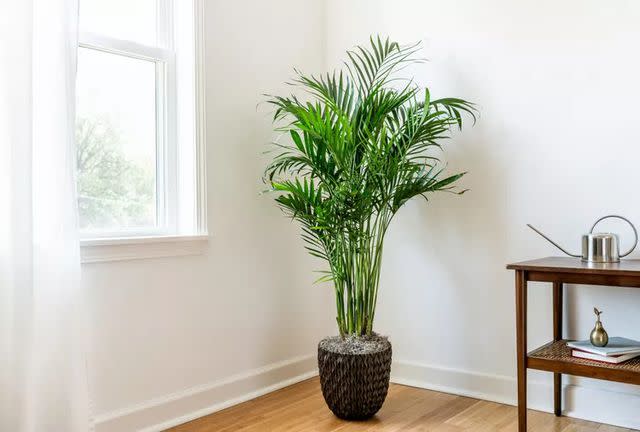
The Spruce / Adrienne Legault
Another popular, low-maintenance houseplant, the small cat palm is known for its elegant, glossy green, feathery fronds. While it's easy to care for this species, it isn’t a fan of overly bright conditions and watch out for spider mite infestations.
Name: Cat Palm (Chamaedorea cataractarum)
Hardiness Zones: 10-11
Light: Partial shade
Soil Needs: Well-draining, loose
Water: Water deeply when soil dries
Mature Size: 6-8 ft. tall outdoors
Foxtail Palm
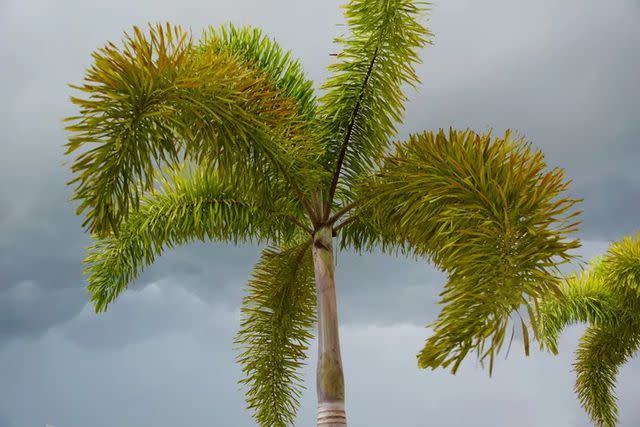
Erica Finstad / Getty Images
The bushy fronds of the foxtail palm are what sets it apart from other palm tree varieties. This fast-growing plant is adaptable to a wide range of soils, providing they are well-draining, it’s drought tolerant, and can handle full sun or partial shade. It also does well as a houseplant if you can offer sufficient light.
Name: Foxtail Palm (Wodyetia bifurcate)
Hardiness Zones: 9-11
Light: Full sun, partial shade
Soil Needs: Well-draining
Water: Water when dry
Mature Size: 8-30 ft. tall outdoors
Lady Palm
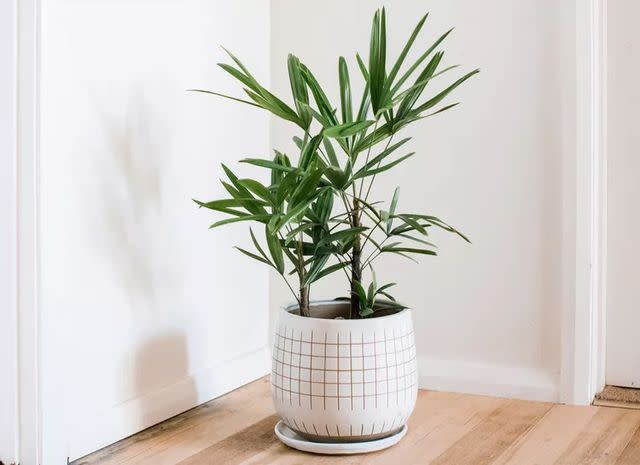
The Spruce / Kara Riley
A popular houseplant, the lady palm tolerates low-light conditions and low humidity levels but still adds a tropical ambiance to your space. In warm regions, you can grow them outdoors. This dense, clump-forming species is an ideal accent in shady shrub borders.
Name: Lady Palm (Rhapis excelsa)
Hardiness Zones: 9-11
Light: Partial shade
Soil Needs: Well-draining
Water: Average water needs
Mature Size: 6-15 ft. tall outdoors
Areca Palm

The Spruce / Alonda Baird
The Areca palm is an elegant species with arching fronds and a resemblance to bamboo. This palm should thrive indoors or out if you can provide a warm spot, high humidity levels, and bright, indirect light.
Name: Areca Palm (Dypsis lutescens; formerly Chrysalidocarpus lutescens)
Hardiness Zones: 10-11
Light: Full sun, partial shade
Soil Needs: Well-draining
Water: Prefers even moisture
Mature Size: 15-30 ft. tall outdoors
Ruffled Fan Palm
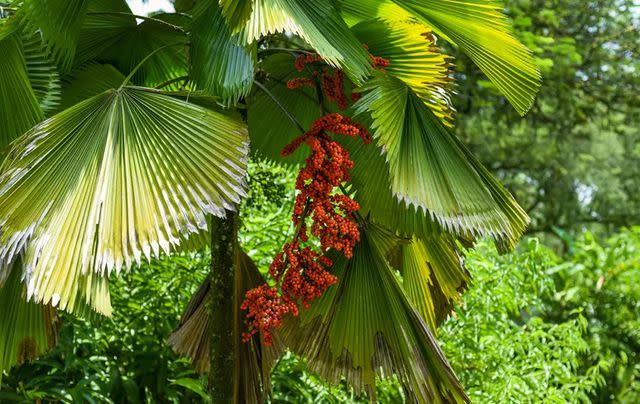
Tatiana Terekhina / Getty Images
The ruffled fan palm stands out for its unique, striking, and closely pleated circular fronds. Its manageable size makes this a good plant for small yards and indoor spaces, providing you can provide the light, warmth, and high humidity levels on which it thrives.
Name: Ruffled Fan Palm (Licuala grandis)
Hardiness Zones: 10-11
Light: Full sun
Soil Needs: Well-draining
Water: Evenly moist
Mature Size: 10-15 ft. tall outdoors
California Fan Palm

The Spruce / Krystal Slagle
Although it’s slow growing, the California fan palm can get big, so it’s best reserved for large yards. This stately tree isn’t the most low-maintenance, as regular pruning is required. The lower leaves stay on the tree after they die, forming unsightly brown clumps that can be a fire hazard.
Name: California Fan Palm (Washingtonia filifera)
Hardiness Zones: 8-11
Light: Full sun, partial shade
Soil Needs: Loose, well-draining
Water: Water deeply when soil dries
Mature Size: 30-80 ft. tall outdoors
Chinese Fan Palm
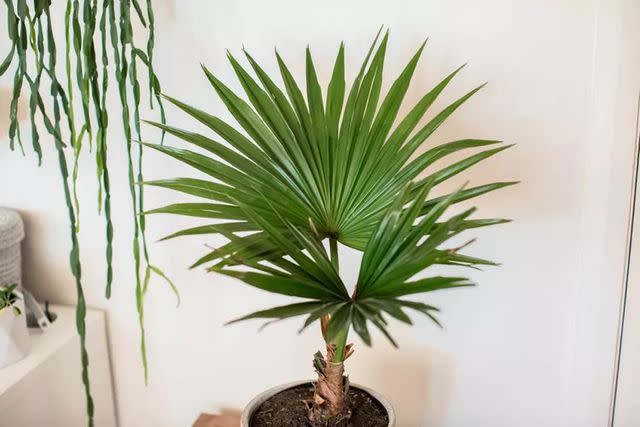
The Spruce / Kara Riley
The Chinese fan palm is a slow-growing, medium-sized palm tree variety featuring long-stalked, fan-shaped, cascading foliage. This plant is relatively low-maintenance, provided you can offer sufficient sun and a warm environment.
Name: Chinese Fan Palm (Livistona chinensis)
Hardiness Zones: 9-11
Light: Full sun, partial shade
Soil Needs: Well-draining, loose
Water: Evenly moist
Mature Size: 30-50 ft. tall outdoors
Majesty Palm
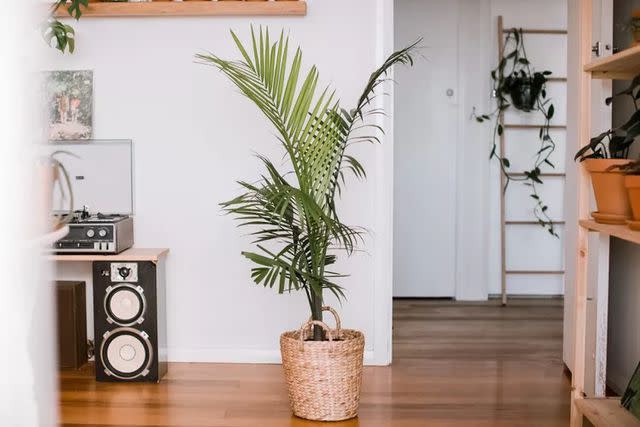
The Spruce / Kara Riley
Too tall for most residential landscapes, the majesty palm, with its long, arching fronds, is often grown as an elegant houseplant. It can be tricky to get the right balance of light, even moisture and humidity to help this plant thrive, so it’s probably not one for brown-thumbed plant collectors.
Name: Majesty Palm (Ravenea rivularis)
Hardiness Zones: 10-11
Light: Partial shade
Soil Needs: Well-draining
Water: Evenly moist
Mature Size: Up to 100 ft. tall outdoors
Kentia Palm
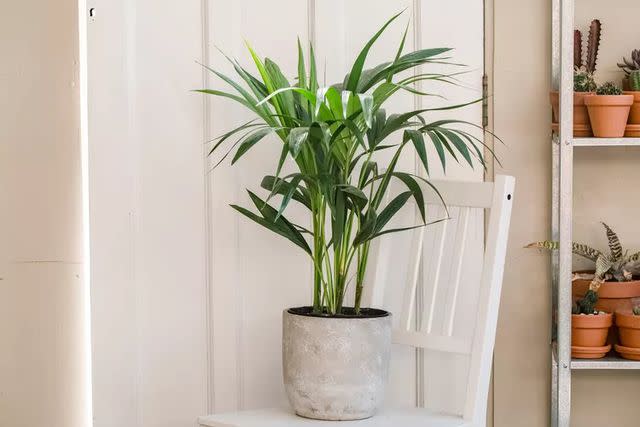
The Spruce / Kara Riley
Consider the Kentia palm if you are looking for an elegant and adaptable species to grow indoors. It adapts to a range of light and soil conditions and the arching, feather-like fronds don’t need the high humidity levels some tropical palms require to thrive.
Name: Kentia Palm (Howea forsteriana)
Hardiness Zones: 9-11
Light: Partial shade
Soil Needs: Well-draining, loose
Water: Evenly moist
Mature Size: Up to 40 ft. tall outdoors
Cabbage Palm
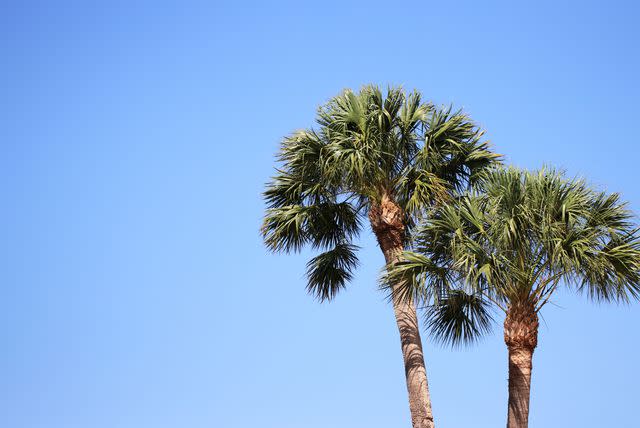
Zen Rial / Getty Images
The cabbage palm is the state tree of Florida and South Carolina. It’s very salt and wind-tolerant and can handle temperatures as low as 15°F. If this tall tree is too large for your yard, consider the dwarf palmetto (Sabal minor) instead.
Name: Cabbage Palm (Sabal palmetto)
Hardiness Zones: 8-11
Light: Full sun
Soil Needs: Well-draining
Water: Evenly moist
Mature Size: Up to 30 ft. tall outdoors
Saw Palmetto
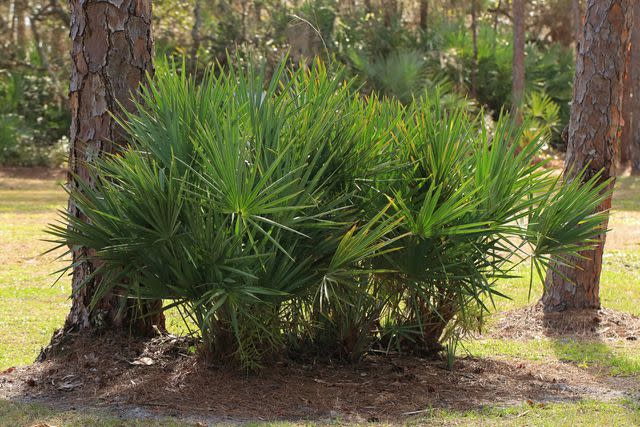
Zen Rial / Getty Images
The saw palmetto is a small, slow-growing, clump-forming species ideal for smaller yards that don’t get direct sun. This hardy species can withstand flooding, wind damage, and periods of drought. Its high salt tolerance makes it ideal for coastal landscaping.
Name: Saw Palmetto (Serenoa repens)
Hardiness Zones: 8-10
Light: Full sun, partial shade
Soil Needs: Loose, well-draining
Water: Water deeply when dry
Mature Size: 8-15 ft. tall outdoors
Jelly Palm
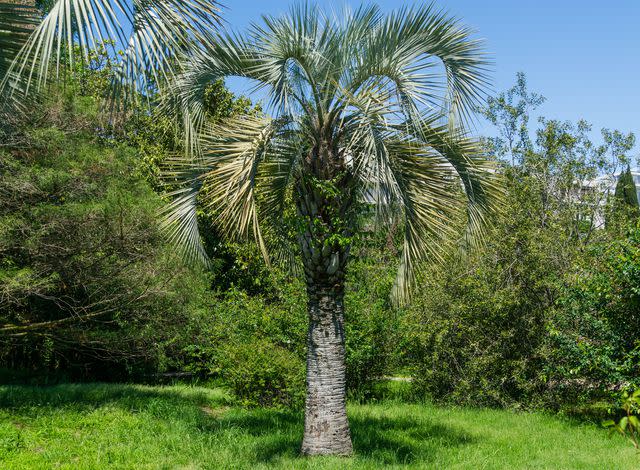
Marina Denisenko / Getty Images
The jelly palm has a lot going for it. This is a cold-hardy, adaptable palm tree variety. Its compact form means it can grow in most residential landscapes, and its curving, feathery fronds add elegance to any space.
Name: Jelly Palm (Butia capitata)
Hardiness Zones: 8-10
Light: Full sun, partial shade
Soil Needs: Loose, well-draining
Water: Prefers even moisture, but is drought-tolerant once established
Mature Size: 10-20 ft. tall outdoors
Bottle Palm
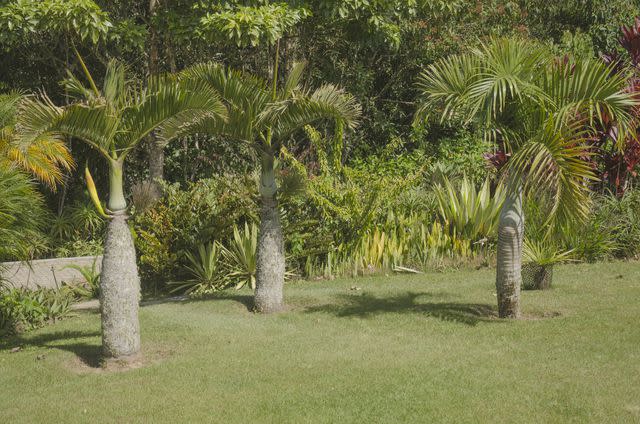
Elizabeth Fernandez / Getty Images
This slow-growing palm tree variety grows best in full sun but can tolerate some shade. The bottle palm gets its name from its unique, compact shape. When young, the plant has a pronounced bulbous, tapering trunk base. This compact palm is suitable for most warm, humid landscapes and grows well in containers and indoors.
Name: Bottle Palm (Hyophorbe lagenicaulis)
Hardiness Zones: 10-11
Light: Full sun
Soil Needs: Well-draining
Water: Evenly moist
Mature Size: 10-15 ft. tall outdoors
Read the original article on The Spruce.

